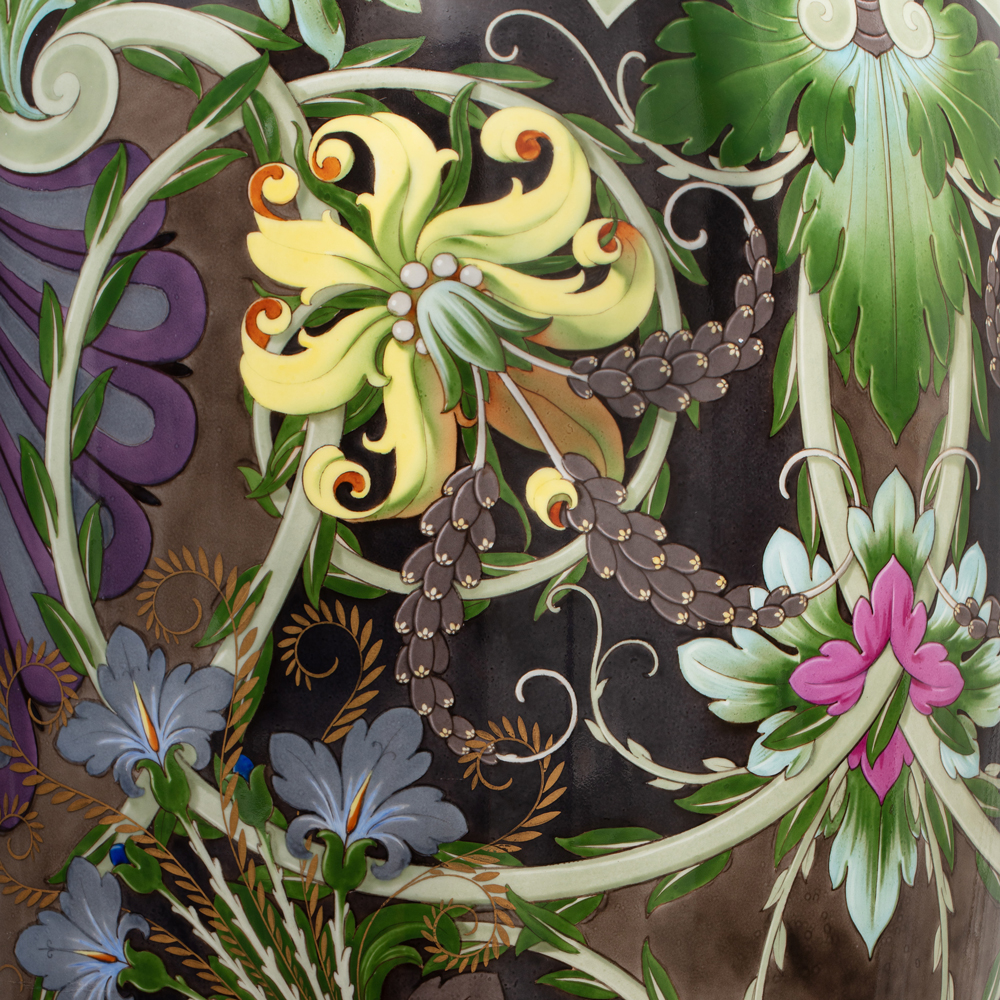Hard-paste porcelain vase in the shape of a 1st size Etruscan carafe, with a taupe background, decorated with foliage and stylized flowers on a brown background, in a large reserve lined with volutes on a gray background, the entourage of which is decorated with turquoise and purple gadroons , edged with stylized green and pink flowers and gold fillets.
The trim in chiseled gilt bronze with handles applied in laurel leaves, rosettes and ribbons, the round foot decorated with a row of pearls.
Very good condition, restorations.
Imperial factory of Sèvres, 1866. Mark with red stamp with the number of the Emperor Napoleon III dated (18)66.
Monogram J.R. of the painter Nicolas Joseph Richard (painter and gilder in Sèvres, active 1830-1872).
H. 105 cm.
Vase of a pair "Renaissance style decoration" entered in the sales shop on February 28, 1867 (Vr' 1st series, n°2, fol. 47 and Vv7, 54), decorated by Joseph Richard between July 1865 and December 1866 ( Vj' 70, 40 and Vj' 71, 39). The ornamental painter was paid 4700 francs for the pair, the bronzes were probably made by Barré. The unit manufacturing cost (per vase) is 3744.50 frs while the unit selling price is 5000 frs, i.e. 10000 frs per pair.
Universal Exhibition, Paris, 1867, under the numbers 138-139.
Not delivered before the fall of the Second Empire in 1870, they were finally delivered to the Ministry of Foreign Affairs building in March 1874 (Vbb 12, f° 70 v°).
Private collection, Nice.
A vase of a second identical pair, dated 1870, kept at the National Museum of Ceramics in Sèvres (inv. MNC7710, ill. 1).
Pair of vases "decorated in gold and colours, cartels of flowers" by Alexandre David (ornaments) and Barré (bronzes), after a drawing by Paul Avisse (ill. 2 and 3), entering the sales store in October 1866 and presented at the Universal Exhibition of 1867, delivered the same year to the Elysée Palace, placed in the grand salon then in the dining room in 1894, kept at the Mobilier National (inv. GML-3207 and GML-3802 ).
The Etruscan carafe shape dates from the beginning of the 19th century, made from Etruscan vases kept in the Louvre (ill. 4). Widely used by Napoleon I and then by Louis-Philippe to receive portraits, the shape was reworked several times. In 1862, it received a new gilt bronze trim designed by Lambert, which is that of our vase. Ornament sculptor, Alphonse François Lambert (1828-1875) worked at the factory from 1852 to 1875.
The author of the decoration is Paul Avisse (1824-1886), whose preparatory drawings are kept in the archives of the factory (ill. 5 and 6). He received his training in the workshop of Séchan et Diéterle, renowned for his important decorative achievements. Avisse provided the model and traced the projects on the piece, the vases were then painted on white by Joseph Richard (active 1830-1872), decorator and painter of ornaments for the factory.
The name of the "Renaissance style" decor is not obvious at first glance, as the traditional naturalistic representation of flowers stands out to already approach the stylization of Art Nouveau; but the foliage, flowers, palmettes and gadroons of our vase are reminiscent of the ornamental style of the 16th century, the prints of which may have influenced Avisse in particular (ill. 7 and 8). The golden age of foliage is the Renaissance, it is treated there in a very special way, with extreme delicacy, and is almost always composed, in the vertical parts, of motifs reproduced symmetrically in relation to a line of axis, which can be found here.
The subtle colors contrast with what Sèvres experienced during the first half of the 19th century. The art of color is taken to new heights following the progress of chemistry, also these chromatic audacity with oriental references characterize the production of the monumental vases of Sèvres under the Second Empire. This decoration illustrates the use of the new muffle background colors, that is to say fired at a moderate temperature in a cassette (Vv7, 54, 36).
The Fastiest of Power, cat. exp., Paris, 2007, cat. 40.
Sèvres, Journal of the Society of Friends of the National Museum of Ceramics, No. 16, 2007, pp. 88-102.











